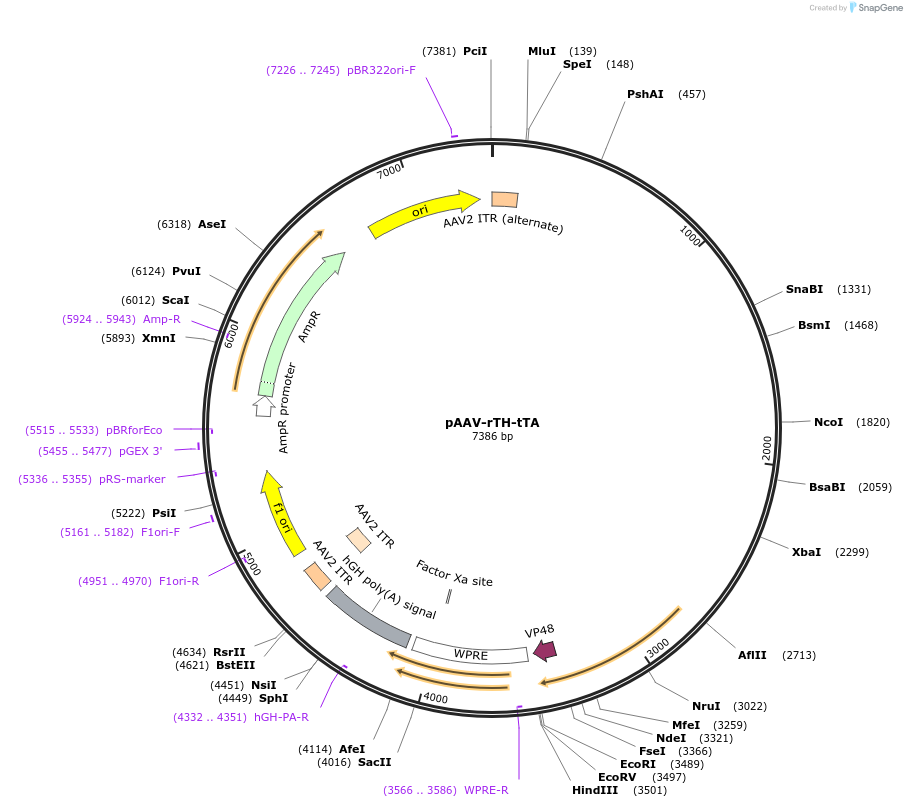pAAV-rTH-tTA
(Plasmid
#133268)
-
PurposeAn AAV genome that expresses tTA from the rat TH promoter
-
Depositing Lab
-
Sequence Information
Ordering
| Item | Catalog # | Description | Quantity | Price (USD) | |
|---|---|---|---|---|---|
| Plasmid | 133268 | Standard format: Plasmid sent in bacteria as agar stab | 1 | $89 | |
Want a viral vector made from this plasmid?
Make a packaging request and we'll get back to you.
Please log in to submit a packaging request.
-
SerotypeSelect serotype for details See details about
-
PricingSelect serotype and quantity $ USD for preparation of µL virus + $32 USD for plasmid.
-
How this works
- Place a request for a quantity of 2 (0.2 mL), 10 (1 mL), 25 (2.5 mL), or 50 (5 mL). Our all-inclusive pricing includes DNA production and QC.
- Addgene will quickly confirm that we can produce a high-quality prep for you.
- Track your request and place an order from within your account. Payment information must be added before we can begin processing your order.
- Receive your prep in 6–9 weeks after the MTA is approved by your organization.
- Learn more about our Packaged on Request Service.
Backbone
-
Vector backbonepAAV
- Backbone size w/o insert (bp) 6655
- Total vector size (bp) 7402
-
Vector typeMammalian Expression, AAV
Growth in Bacteria
-
Bacterial Resistance(s)Ampicillin, 100 μg/mL
-
Growth Temperature30°C
-
Growth Strain(s)NEB Stable
-
Copy numberHigh Copy
Gene/Insert
-
Gene/Insert nametTA
-
Alt nameTetracycline transactivator
-
Insert Size (bp)747
-
Mutation*(see below)
- Promoter rTH
Cloning Information
- Cloning method Restriction Enzyme
- 5′ cloning site MluI (not destroyed)
- 3′ cloning site AflII (not destroyed)
- 5′ sequencing primer N/A
- 3′ sequencing primer N/A
- (Common Sequencing Primers)
Resource Information
-
Supplemental Documents
Terms and Licenses
-
Academic/Nonprofit Terms
-
Industry Terms
- Not Available to Industry
Trademarks:
- Zeocin® is an InvivoGen trademark.
Depositor Comments
Funded by BRAIN initiative
*Note: The tTA in this plasmid was made from a reverse tetracycline transactivator (rtTA) by changing two amino acids (G19E and P56A). These two residue changes have been shown to be sufficient for the reverse phenotype (10.1073/pnas.130192197).
These plasmids were created by your colleagues. Please acknowledge the Principal Investigator, cite the article in which the plasmids were described, and include Addgene in the Materials and Methods of your future publications.
-
For your Materials & Methods section:
pAAV-rTH-tTA was a gift from Viviana Gradinaru (Addgene plasmid # 133268 ; http://n2t.net/addgene:133268 ; RRID:Addgene_133268) -
For your References section:
Optical dopamine monitoring with dLight1 reveals mesolimbic phenotypes in a mouse model of neurofibromatosis type 1. Robinson JE, Coughlin GM, Hori AM, Cho JR, Mackey ED, Turan Z, Patriarchi T, Tian L, Gradinaru V. Elife. 2019 Sep 23;8. pii: 48983. doi: 10.7554/eLife.48983. 10.7554/eLife.48983 PubMed 31545171








